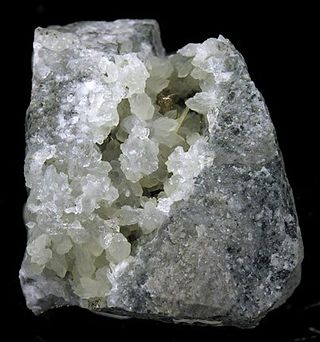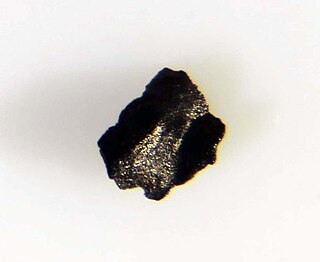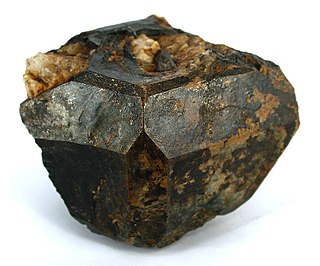
Hematite, also spelled as haematite, is a common iron oxide compound with the formula, Fe2O3 and is widely found in rocks and soils. Hematite crystals belong to the rhombohedral lattice system which is designated the alpha polymorph of Fe
2O
3. It has the same crystal structure as corundum (Al
2O
3) and ilmenite (FeTiO
3). With this it forms a complete solid solution at temperatures above 950 °C (1,740 °F).

Cinnabar, or cinnabarite, is the bright scarlet to brick-red form of mercury(II) sulfide (HgS). It is the most common source ore for refining elemental mercury and is the historic source for the brilliant red or scarlet pigment termed vermilion and associated red mercury pigments.

Chalcopyrite ( KAL-kə-PY-ryte, -koh-) is a copper iron sulfide mineral and the most abundant copper ore mineral. It has the chemical formula CuFeS2 and crystallizes in the tetragonal system. It has a brassy to golden yellow color and a hardness of 3.5 to 4 on the Mohs scale. Its streak is diagnostic as green-tinged black.

Mangalia, ancient Callatis, is a city and a port on the coast of the Black Sea in the south-east of Constanța County, Northern Dobruja, Romania.

Galena, also called lead glance, is the natural mineral form of lead(II) sulfide (PbS). It is the most important ore of lead and an important source of silver.

In mineralogy, argentite (from Latin argentum ' silver') is cubic silver sulfide (Ag2S), which can only exist at temperatures above 173 °C (343 °F), 177 °C (351 °F), or 179 °C (354 °F). When it cools to ordinary temperatures it turns into its monoclinic polymorph, acanthite. The International Mineralogical Association has decided to reject argentite as a proper mineral.

Acanthite is a form of silver sulfide with the chemical formula Ag2S. It crystallizes in the monoclinic system and is the stable form of silver sulfide below 173 °C (343 °F). Argentite is the stable form above that temperature. As argentite cools below that temperature its cubic form is distorted to the monoclinic form of acanthite. Below 173 °C acanthite forms directly. Acanthite is the only stable form in normal air temperature.

Samsonite International S.A. is a luggage manufacturer and retailer, with products ranging from large suitcases to small toiletries bags and briefcases. The company was founded in Denver, Colorado, United States. Its registered office is in Luxembourg and it is listed on the Hong Kong Stock Exchange.

Copper(II) oxide or cupric oxide is an inorganic compound with the formula CuO. A black solid, it is one of the two stable oxides of copper, the other being Cu2O or copper(I) oxide (cuprous oxide). As a mineral, it is known as tenorite. It is a product of copper mining and the precursor to many other copper-containing products and chemical compounds.

Pyrargyrite is a sulfosalt mineral consisting of silver sulfantimonite, Ag3SbS3. Known also as dark red silver ore or ruby silver, it is an important source of the metal.

Krennerite is an orthorhombic gold telluride mineral which can contain variable amounts of silver in the structure. The formula is AuTe2, but specimen with gold substituted by up to 24% with silver have been found ([Au0.77Ag0.24]Te2). Both of the chemically similar gold-silver tellurides, calaverite and sylvanite, are in the monoclinic crystal system, whereas krennerite is orthorhombic.

Laurite is an opaque black, metallic ruthenium sulfide mineral with formula: RuS2. It crystallizes in the isometric system. It is in the pyrite structural group. Though it's been found in many localities worldwide, it is extremely rare.

Sulfosalt minerals are sulfide minerals with the general formula AmBnXp, where

Freieslebenite is a sulfosalt mineral composed of antimony, lead, and silver. Sulfosalt minerals are complex sulfide minerals with the formula: AmBnSp. The formula of freieslebenite is AgPbSbS3.

Breithauptite is a nickel antimonide mineral with the simple formula NiSb. Breithauptite is a metallic opaque copper-red mineral crystallizing in the hexagonal - dihexagonal dipyramidal crystal system. It is typically massive to reniform in habit, but is observed as tabular crystals. It has a Mohs hardness of 3.5 to 4 and a specific gravity of 8.23.

Gersdorffite or Nickel glance is a nickel arsenic sulfide mineral with formula NiAsS. It crystallizes in the isometric system showing diploidal symmetry. It occurs as euhedral to massive opaque, metallic grey-black to silver white forms. Gersdorffite belongs to a solid solution series with cobaltite, CoAsS. Antimony freely substitutes also leading to ullmannite, NiSbS. It has a Mohs hardness of 5.5 and a specific gravity of 5.9 to 6.33.

Chlorargyrite is the mineral form of silver chloride (AgCl). Chlorargyrite occurs as a secondary mineral phase in the oxidation of silver mineral deposits. It crystallizes in the isometric - hexoctahedral crystal class. Typically massive to columnar in occurrence it also has been found as colorless to variably yellow cubic crystals. The color changes to brown or purple on exposure to light. It is quite soft with a Mohs hardness of 1 to 2 and dense with a specific gravity of 5.55. It is also known as cerargyrite and, when weathered by desert air, as horn silver. Bromian chlorargyrite is also common. Chlorargyrite is water-insoluble.

Microlite was once known as a pale-yellow, reddish-brown, or black isometric mineral composed of sodium calcium tantalum oxide with a small amount of fluorine. Its chemical formula is(Na,Ca)2Ta2O6(O,OH,F). Today it is a name of a group of oxide minerals of a similar stoichiometry having tantalum prevailing over titanium and niobium. The microlite group belongs to a large pyrochlore supergroup that occurs in pegmatites and constitutes an ore of tantalum. It has a Mohs hardness of 5.5 and a variable specific gravity of 4.2 to 6.4. It occurs as disseminated microscopic subtranslucent to opaque octahedral crystals with a refractive index of 2.0 to 2.2. Microlite is also called djalmaite, but both names are now obsolete.

Howlite, a calcium borosilicate hydroxide (Ca2B5SiO9(OH)5), is a borate mineral found in evaporite deposits.

The silver antimonide mineral dyscrasite has the chemical formula Ag3Sb. It is an opaque, silver white, metallic mineral which crystallizes in the orthorhombic crystal system. It forms pyramidal crystals up to 5 cm (2.0 in) and can also form cylindrical and prismatic crystals.




















